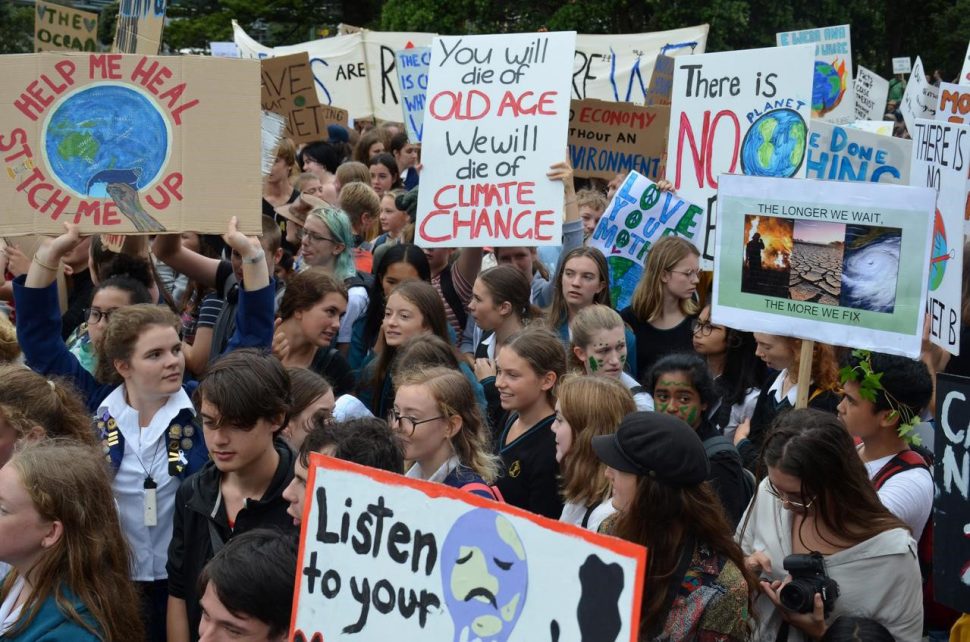SYDNEY/LONDON, (Reuters) – Tens of thousands of school students around the world walked out of classes yesterday in a global strike to protest against government inaction on climate change.
“Climate change is worse than Voldemort,” read a handmade sign carried by one student in Wellington, referring to the evil wizard in the hugely popular Harry Potter books and films.
“The oceans are rising, so are we,” read another in Sydney.
In Europe, students packed streets and squares in Paris, Madrid, Rome, Brussels and other cities for “Fridays for Future” protests.
Demonstrations also took place across the United States. In Washington, some 1,500 students rallied in front of the Capitol chanting “climate action now!” and waving homemade placards with slogans such as “Our planet, our future.”
The worldwide student strike movement started in August 2018, when 16-year-old Swedish climate activist Greta Thunberg began protesting outside her parliament on school days. She has since been nominated for the Nobel Peace Prize.
On Friday, she spoke at a Stockholm demonstration. Other rallies were held in 100 towns around Sweden.
“We have only been born into this world, we are going to have to live with this crisis our whole lives. So will our children and grandchildren and coming generations,” Thunberg said. “We are not going to accept this. We are striking because we want a future and we are going to carry on.”
Thousands marched through central London with banners reading “The future is in our hands” and “We’re missing lessons to teach you one”.
“Education is important but climate change is more important,” 14-year-old Molly Powell said.
United Nations Secretary-General Antonio Guterres tweeted his support on Friday evening. “Young people can, and do, change the world,” he said. “You understand we are in a race for your lives; your commitment & activism makes me confident we will win it.”
Scientists say fossil fuel use releases greenhouse gases that trap heat and lift global temperatures, bringing more floods, droughts, heatwaves and rising sea levels.
The 2015 Paris climate conference pledge to keep the increase in global average temperatures to below 2 degrees Celsius (35 F) above pre-industrial levels requires a radical cutback in use of coal and fossil fuels.
In Düsseldorf, Germany, some 2,000 schoolchildren paraded with a carnival float depicting a giant effigy of Thunberg with “Do something about the climate catastrophe at last” written on her raised arms.
They stopped around the city, home to the headquarters of many of Germany’s largest manufacturers, reading out calls for change. “The clock is ticking and time is against us!” they shouted. “We are the last generation that can fix this.”
About 60 students protested at government house in Bangkok, holding cardboard signs to campaign against plastic. Thailand is one of the world’s worst marine plastic polluters.
“As youths who will inherit the land, we gather here to demand that the government work with us to solve these problems,” said 17-year-old Thiti Usanakul, of student-led group Grin Green International.
The group was later invited to meet officials at the Ministry of Natural Resources and Environment in two weeks.
There were also demonstrations in South Korea, India and South Africa. In Singapore, where strict laws regulate public assembly, young people planned a virtual campaign on social media.
New Zealand Prime Minister Jacinda Ardern supported the strikes, saying teenagers should not wait for voting age to use their voices.
That contrasted with politicians in Australia and Britain, who rebuked them for missing lessons.
“For action on issues that they think is important, they should do that after school or on weekends,” said Dan Tehan, Australia’s education minister.
Wellington parent Alex, who marched beside his 11-year-old son, disagreed: “It’s a much better day of education. This is the greatest issue of our time.”





